Macrophage-Myofibroblast Transition Contributes to Myofibroblast Formation in Proliferative Vitreoretinal Disorders
Abstract
:1. Introduction
2. Results
2.1. Neovascularization and Expression of Myofibroblast Markers in Epiretinal Fibrovascular Membranes from Patients with PDR
2.2. Expression of Myofibroblast Markers in Epiretinal Fibrocellular Membranes from Patients with PVR
2.3. CD68+ Monocytes/Macrophages Are Predominantly CD206+ M2 Phenotype in Epiretinal Membranes
2.4. CD206+ Cells in Epiretinal Membranes from Patients with PDR and PVR
2.5. Characterization of the Cells Containing Pigment in Epiretinal Fibrocellular Membranes from Patients with PVR
2.6. Intermediate CD68+/α-SMA+ and CD68+/FSP-1+ Double-Positive Cells in Epiretinal Membranes from Patients with PDR and PVR
2.7. CD206+ M2 Macrophages Contribute to MMT in Epiretinal Membranes from Patients with PDR and PVR
2.8. Expression of TGF-ß1 and ß-Catenin in Epiretinal Membranes from Patients with PDR and PVR
2.9. Levels of sCD206 and sFAP-α in Vitreous Samples from Control Patients and Patients with PDR and PVR
2.10. Proinflammatory TNF-α and the Hypoxia Mimetic Agent CoCl2, but Not Proangiogenic VEGF Induce Upregulation of sFAP-α in Retinal Müller Glial Cells
3. Discussion
4. Materials and Methods
4.1. Vitreous Humor Samples and Epiretinal Membrane Specimens
4.2. Immunohistochemical Staining of Human Epiretinal Membranes
4.3. Human Retinal Müller Glial Cell and Human Retinal Microvascular Endothelial Cell Cultures
4.4. Enzyme-Linked Immunosorbent Assay
4.5. Flow Cytometry
4.6. Statistical Analysis
5. Conclusions
Author Contributions
Funding
Institutional Review Board Statement
Informed Consent Statement
Data Availability Statement
Acknowledgments
Conflicts of Interest
References
- Abu El-Asrar, A.M.; Nawaz, M.I.; Ahmad, A.; Siddiquei, M.M.; Allegaert, E.; Gikandi, P.W.; De Hertogh, G.; Opdenakker, G. Proprotein convertase furin is a driver and potential therapeutic target in proliferative diabetic retinopathy. Clin. Exp. Ophthalmol. 2022, 50, 632–652. [Google Scholar] [PubMed]
- Abu El-Asrar, A.M.; Ahmad, A.; Allegaert, E.; Siddiquei, M.M.; Gikandi, P.W.; De Hertogh, G.; Opdenakker, G. Interleukin-11 overexpression and M2 macrophage density are associated with angiogenic activity in proliferative diabetic retinopathy. Ocul. Immunol. Inflamm. 2020, 28, 575–588. [Google Scholar] [PubMed]
- Abu El-Asrar, A.M.; De Hertogh, G.; Van den Eynde, K.; Alam, K.; Van Raemdonck, K.; Opdenakker, G.; Van Damme, J.; Geboes, K.; Struyf, S. Myofibroblasts in proliferative diabetic retinopathy can originate from infiltrating fibrocytes and through endothelial-to-mesenchymal transition (EndoMT). Exp. Eye Res. 2015, 132, 179–189. [Google Scholar] [PubMed]
- Abu El-Asrar, A.M.; Struyf, S.; Van Damme, J.; Geboes, K. Circulating fibrocytes contribute to the myofibroblast population in proliferative vitreoretinopathy epiretinal membranes. Br. J. Ophthalmol. 2008, 92, 699–704. [Google Scholar] [CrossRef]
- Abu El-Asrar, A.M.; Nawaz, M.I.; De Hertogh, G.; Alam, K.; Siddiquei, M.M.; Van den Eynde, K.; Mousa, A.; Mohammad, G.; Geboes, K.; Opdenakker, G. S100A4 is upregulated in proliferative diabetic retinopathy and correlates with markers of angiogenesis and fibrogenesis. Mol. Vis. 2014, 20, 1209–1224. [Google Scholar]
- Cheng, P.; Li, S.; Chen, H. Macrophages in lung injury, repair, and fibrosis. Cells 2021, 10, 436. [Google Scholar] [CrossRef]
- Wang, X.; Chen, J.; Xu, J.; Xie, J.; Harris, D.C.H.; Zheng, G. The role of macrophages in kidney fibrosis. Front. Physiol. 2021, 12, 705838. [Google Scholar]
- Braga, T.T.; Agudelo, J.S.H.; Camara, N.O.S. Macrophages During the Fibrotic Process: M2 as Friend and Foe. Front. Immunol. 2015, 6, 602. [Google Scholar]
- Wynn, T.A. Cellular and molecular mechanisms of fibrosis. J. Pathol. 2008, 214, 199–210. [Google Scholar]
- Nurmik, M.; Ullmann, P.; Rodriguez, F.; Haan, S.; Letellier, E. In search of definitions: Cancer-associated fibroblasts and their markers. Int. J. Cancer 2020, 146, 895–905. [Google Scholar] [CrossRef]
- Juillerat-Jeanneret, L.; Tafelmeyer, P.; Golshayan, D. Regulation of fibroblast activation protein-alpha expression: Focus on intracellular protein interactions. J. Med. Chem. 2021, 64, 14028–14045. [Google Scholar] [CrossRef] [PubMed]
- Fitzgerald, A.A.; Weiner, L.M. The role of fibroblast activation protein in health and malignancy. Cancer Metastasis Rev. 2020, 39, 783–803. [Google Scholar] [CrossRef]
- Priglinger, C.S.; Obermann, J.; Szober, C.M.; Merl-Pham, J.; Ohmayer, U.; Behler, J.; Gruhn, F.; Kreutzer, T.C.; Wertheimer, C.; Geerlof, A.; et al. Epithelial-to-mesenchymal transition of RPE cells in vitro confers increased beta1,6-N-glycosylation and increased susceptibility to Galectin-3 binding. PLoS ONE 2016, 11, e0146887. [Google Scholar] [CrossRef] [PubMed]
- Tamiya, S.; Kaplan, H.J. Role of epithelial-mesenchymal transition in proliferative vitreoretinopathy. Exp. Eye Res. 2016, 142, 26–31. [Google Scholar] [CrossRef]
- Boneva, S.K.; Wolf, J.; Hajdu, R.I.; Prinz, G.; Salie, H.; Schlecht, A.; Killmer, S.; Laich, Y.; Faatz, H.; Lommatzsch, A.; et al. In-depth molecular characterization of neovascular membranes suggests a role for hyalocyte-to-myofibroblast transdifferentiation in proliferative diabetic retinopathy. Front. Immunol. 2021, 12, 757607. [Google Scholar] [CrossRef] [PubMed]
- Torres, A.; Munoz, K.; Nahuelpan, Y.; R Saez, A.-P.; Mendoza, P.; Jara, C.; Cappelli, C.; Suarez, R.; Oyarzun, C.; Quezada, C.; et al. Intraglomerular monocyte/macrophage infiltration and macrophage-myofibroblast transition during diabetic nephropathy is regulated by the A(2B) adenosine receptor. Cells 2020, 9, 1051. [Google Scholar] [CrossRef]
- Wang, Y.Y.; Jiang, H.; Pan, J.; Huang, X.R.; Wang, Y.C.; Huang, H.F.; To, K.F.; Nikolic-Paterson, D.J.; Lan, H.Y.; Chen, J.H. Macrophage-to-myofibroblast transition contributes to interstitial fibrosis in chronic renal allograft injury. J. Am. Soc. Nephrol. 2017, 28, 2053–2067. [Google Scholar] [CrossRef]
- Yang, F.; Chang, Y.; Zhang, C.; Xiong, Y.; Wang, X.; Ma, X.; Wang, Z.; Li, H.; Shimosawa, T.; Pei, L.; et al. UUO induces lung fibrosis with macrophage-myofibroblast transition in rats. Int. Immunopharmacol. 2021, 93, 107396. [Google Scholar] [CrossRef]
- Haider, N.; Bosca, L.; Zandbergen, H.R.; Kovacic, J.C.; Narula, N.; Gonzalez-Ramos, S.; Fernandez-Velasco, M.; Agrawal, S.; Paz-Garcia, M.; Gupta, S.; et al. Transition of macrophages to fibroblast-like cells in healing myocardial infarction. J. Am. Coll. Cardiol. 2019, 74, 3124–3135. [Google Scholar] [CrossRef]
- Xiong, Y.; Chang, Y.; Hao, J.; Zhang, C.; Yang, F.; Wang, Z.; Liu, Y.; Wang, X.; Mu, S.; Xu, Q. Eplerenone attenuates fibrosis in the contralateral kidney of UUO rats by preventing macrophage-to-myofibroblast transition. Front. Pharmacol. 2021, 12, 620433. [Google Scholar] [CrossRef]
- Wang, S.; Meng, X.M.; Ng, Y.Y.; Ma, F.Y.; Zhou, S.; Zhang, Y.; Yang, C.; Huang, X.R.; Xiao, J.; Wang, Y.Y.; et al. TGF-beta/SMAD3 signalling regulates the transition of bone marrow-derived macrophages into myofibroblasts during tissue fibrosis. Oncotarget 2016, 7, 8809–8822. [Google Scholar] [CrossRef]
- Vierhout, M.; Ayoub, A.; Naiel, S.; Yazdanshenas, P.; Revill, S.D.; Reihani, A.; Dvorkin-Gheva, A.; Shi, W.; Ask, K. Monocyte and macrophage derived myofibroblasts: Is it fate? A review of the current evidence. Wound Repair. Regen. 2021, 29, 548–562. [Google Scholar] [CrossRef]
- Tang, P.C.; Chung, J.Y.; Xue, V.W.; Xiao, J.; Meng, X.M.; Huang, X.R.; Zhou, S.; Chan, A.S.; Tsang, A.C.; Cheng, A.S.; et al. SMAD3 promotes cancer-associated fibroblasts generation via macrophage-myofibroblast transition. Adv. Sci. Weinh 2022, 9, e2101235. [Google Scholar] [CrossRef] [PubMed]
- Chilosi, M.; Poletti, V.; Zamo, A.; Lestani, M.; Montagna, L.; Piccoli, P.; Pedron, S.; Bertaso, M.; Scarpa, A.; Murer, B.; et al. Aberrant Wnt/beta-catenin pathway activation in idiopathic pulmonary fibrosis. Am. J. Pathol. 2003, 162, 1495–1502. [Google Scholar] [CrossRef] [PubMed]
- Brokopp, C.E.; Schoenauer, R.; Richards, P.; Bauer, S.; Lohmann, C.; Emmert, M.Y.; Weber, B.; Winnik, S.; Aikawa, E.; Graves, K.; et al. Fibroblast activation protein is induced by inflammation and degrades type I collagen in thin-cap fibroatheromata. Eur. Heart J. 2011, 32, 2713–2722. [Google Scholar] [CrossRef] [PubMed]
- Tang, P.M.; Nikolic-Paterson, D.J.; Lan, H.Y. Macrophages: Versatile players in renal inflammation and fibrosis. Nat. Rev. Nephrol. 2019, 15, 144–158. [Google Scholar] [CrossRef] [PubMed]
- Tan-Garcia, A.; Lai, F.; Sheng Yeong, J.P.; Irac, S.E.; Ng, P.Y.; Msallam, R.; Tatt Lim, J.C.; Wai, L.E.; Tham, C.Y.L.; Choo, S.P.; et al. Liver fibrosis and CD206(+) macrophage accumulation are suppressed by anti-GM-CSF therapy. JHEP Rep. 2020, 2, 100062. [Google Scholar] [CrossRef]
- Li, S.; Gao, S.; Jiang, Q.; Liang, Q.; Luan, J.; Zhang, R.; Zhang, F.; Ruan, H.; Li, X.; Li, X.; et al. Clevudine attenuates bleomycin-induced early pulmonary fibrosis via regulating M2 macrophage polarization. Int. Immunopharmacol. 2021, 101 Pt B, 108271. [Google Scholar] [CrossRef]
- Motz, K.; Lina, I.; Murphy, M.K.; Drake, V.; Davis, R.; Tsai, H.W.; Feeley, M.; Yin, L.X.; Ding, D.; Hillel, A. M2 macrophages promote collagen expression and synthesis in laryngotracheal stenosis fibroblasts. Laryngoscope 2021, 131, E346–E353. [Google Scholar] [CrossRef]
- Laich, Y.; Wolf, J.; Hajdu, R.I.; Schlecht, A.; Bucher, F.; Pauleikhoff, L.; Busch, M.; Martin, G.; Faatz, H.; Killmer, S.; et al. Single-cell protein and transcriptional characterization of epiretinal membranes from patients with proliferative vitreoretinopathy. Investig. Ophthalmol. Vis. Sci. 2022, 63, 17. [Google Scholar] [CrossRef]
- Zhang, J.; Zhou, Q.; Yuan, G.; Dong, M.; Shi, W. Notch signaling regulates M2 type macrophage polarization during the development of proliferative vitreoretinopathy. Cell. Immunol. 2015, 298, 77–82. [Google Scholar] [CrossRef] [PubMed]
- Abu El-Asrar, A.M.; Struyf, S.; Kangave, D.; Geboes, K.; Van Damme, J. Chemokines in proliferative diabetic retinopathy and proliferative vitreoretinopathy. Eur. Cytokine Netw. 2006, 17, 155–165. [Google Scholar] [CrossRef] [PubMed]
- Abu El-Asrar, A.M.; Nawaz, M.I.; Ahmad, A.; De Zutter, A.; Siddiquei, M.M.; Blanter, M.; Allegaert, E.; Gikandi, P.W.; De Hertogh, G.; Van Damme, J.; et al. Evaluation of proteoforms of the transmembrane chemokines CXCL16 and CX3CL1, their receptors, and their processing metalloproteinases ADAM10 and ADAM17 in proliferative diabetic retinopathy. Front. Immunol. 2020, 11, 601639. [Google Scholar] [CrossRef] [PubMed]
- Cui, Y.; Luo, Y.; Qian, Q.; Tian, J.; Fang, Z.; Wang, X.; Zeng, Y.; Wu, J.; Li, Y. Sanguinarine regulates tumor-associated macrophages to prevent lung cancer angiogenesis through the WNT/beta-catenin pathway. Front. Oncol. 2022, 12, 732860. [Google Scholar] [CrossRef]
- Lee, C.; Jeong, H.; Bae, Y.; Shin, K.; Kang, S.; Kim, H.; Oh, J.; Bae, H. Targeting of M2-like tumor-associated macrophages with a melittin-based pro-apoptotic peptide. J. Immunother. Cancer 2019, 7, 147. [Google Scholar] [CrossRef]
- Shou, Y.; Wang, X.; Chen, C.; Liang, Y.; Yang, C.; Xiao, Q.; Li, H.; Wang, S.; Shu, J.; Tian, X.; et al. Exosomal miR-301a-3p from esophageal squamous cell carcinoma cells promotes angiogenesis by inducing M2 polarization of macrophages via the PTEN/PI3K/AKT signaling pathway. Cancer Cell Int. 2022, 22, 153. [Google Scholar] [CrossRef]
- Ono, Y.; Yoshino, O.; Hiraoka, T.; Sato, E.; Furue, A.; Nawaz, A.; Hatta, H.; Fukushi, Y.; Wada, S.; Tobe, K.; et al. CD206+ macrophage is an accelerator of endometriotic-like lesion via promoting angiogenesis in the endometriosis mouse model. Sci. Rep. 2021, 11, 853. [Google Scholar] [CrossRef]
- Nielsen, M.C.; Hvidbjerg Gantzel, R.; Claria, J.; Trebicka, J.; Moller, H.J.; Gronbaek, H. Macrophage activation markers, CD163 and CD206, in acute-on-chronic liver failure. Cells 2020, 9, 1175. [Google Scholar] [CrossRef]
- Nielsen, M.C.; Andersen, M.N.; Rittig, N.; Rodgaard-Hansen, S.; Gronbaek, H.; Moestrup, S.K.; Moller, H.J.; Etzerodt, A. The macrophage-related biomarkers sCD163 and sCD206 are released by different shedding mechanisms. J. Leukoc. Biol. 2019, 106, 1129–1138. [Google Scholar] [CrossRef]
- Groger, M.; Holnthoner, W.; Maurer, D.; Lechleitner, S.; Wolff, K.; Mayr, B.B.; Lubitz, W.; Petzelbauer, P. Dermal microvascular endothelial cells express the 180-kDa macrophage mannose receptor in situ and in vitro. J. Immunol. 2000, 165, 5428–5434. [Google Scholar] [CrossRef]
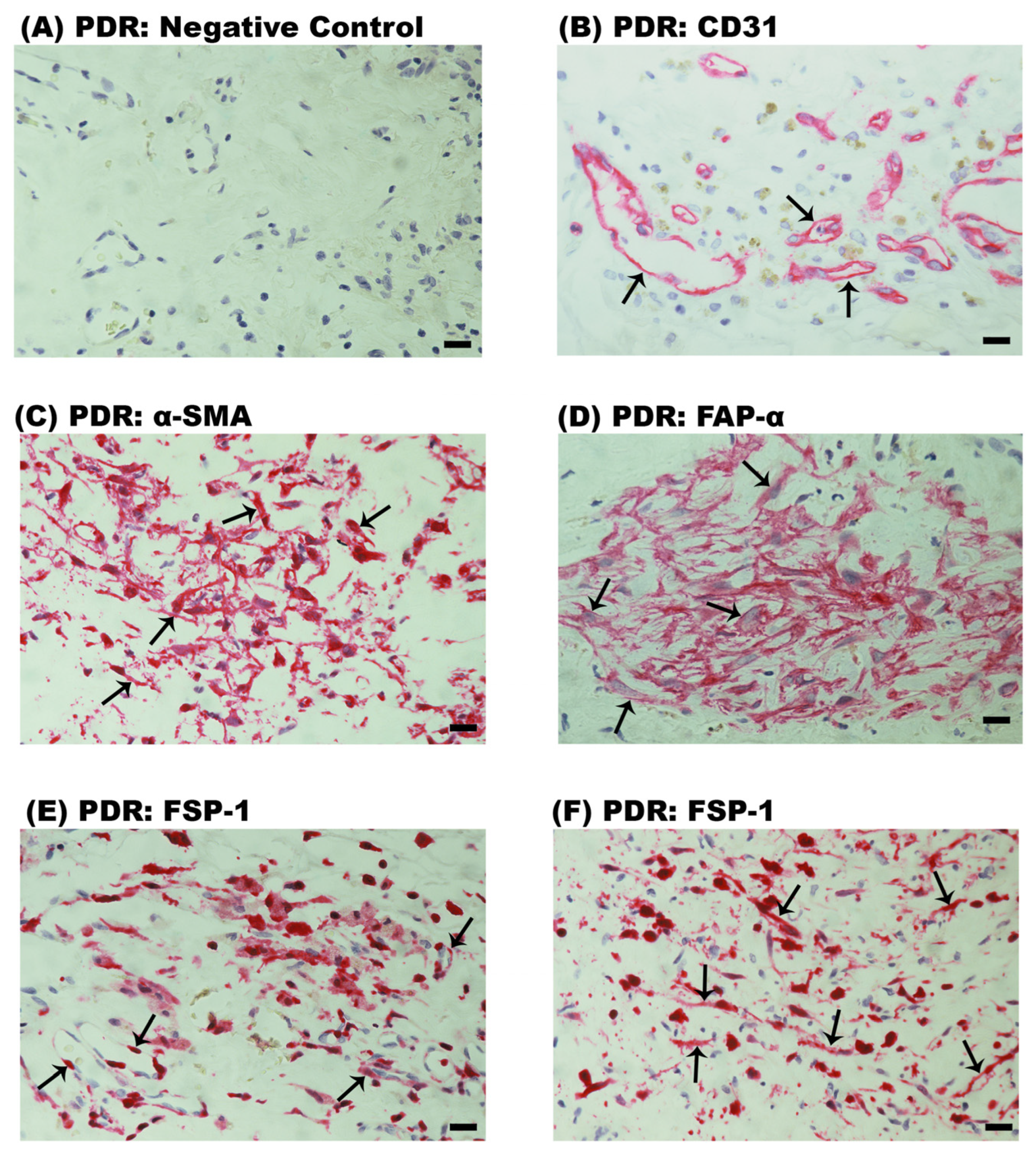
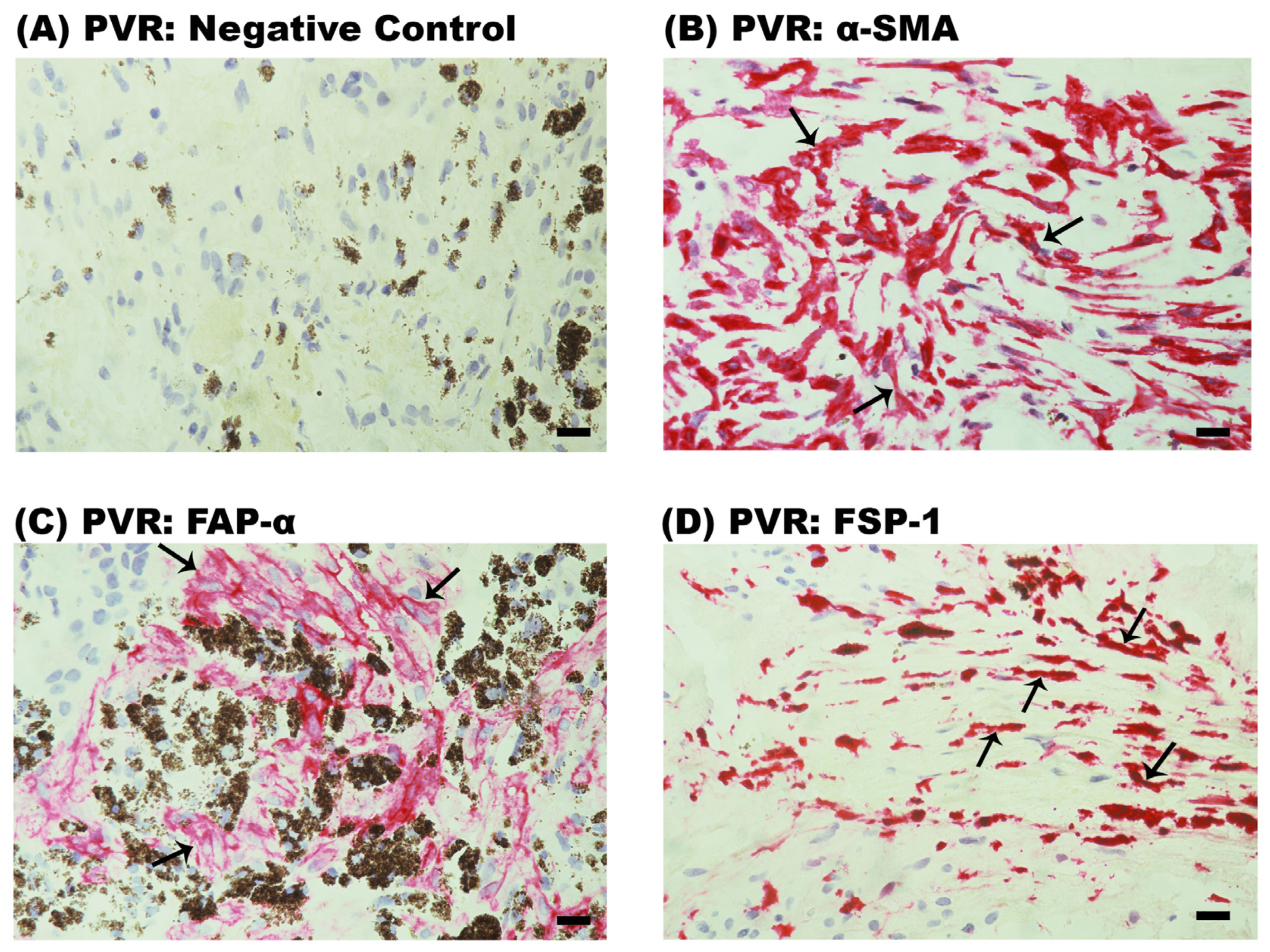
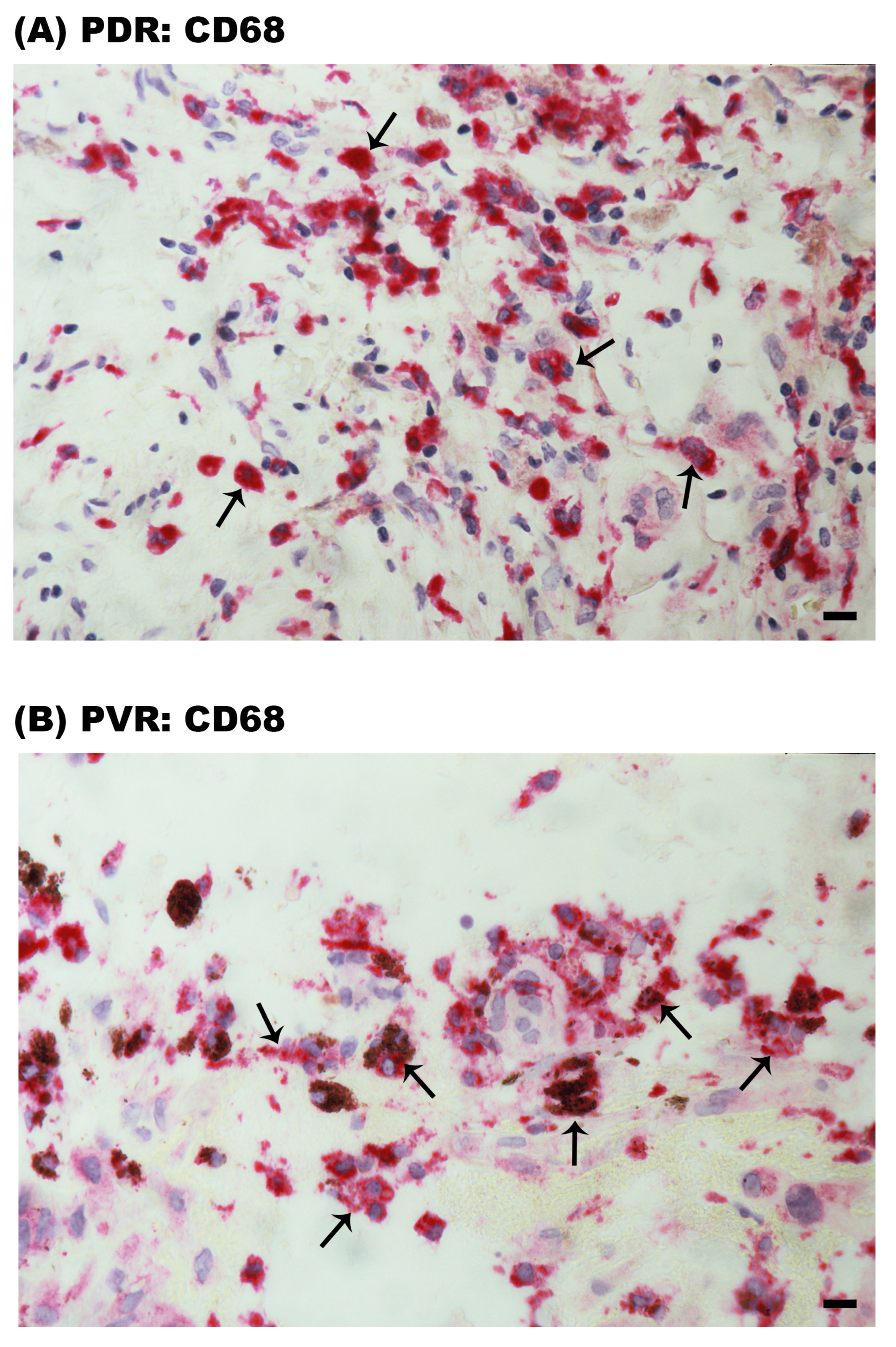
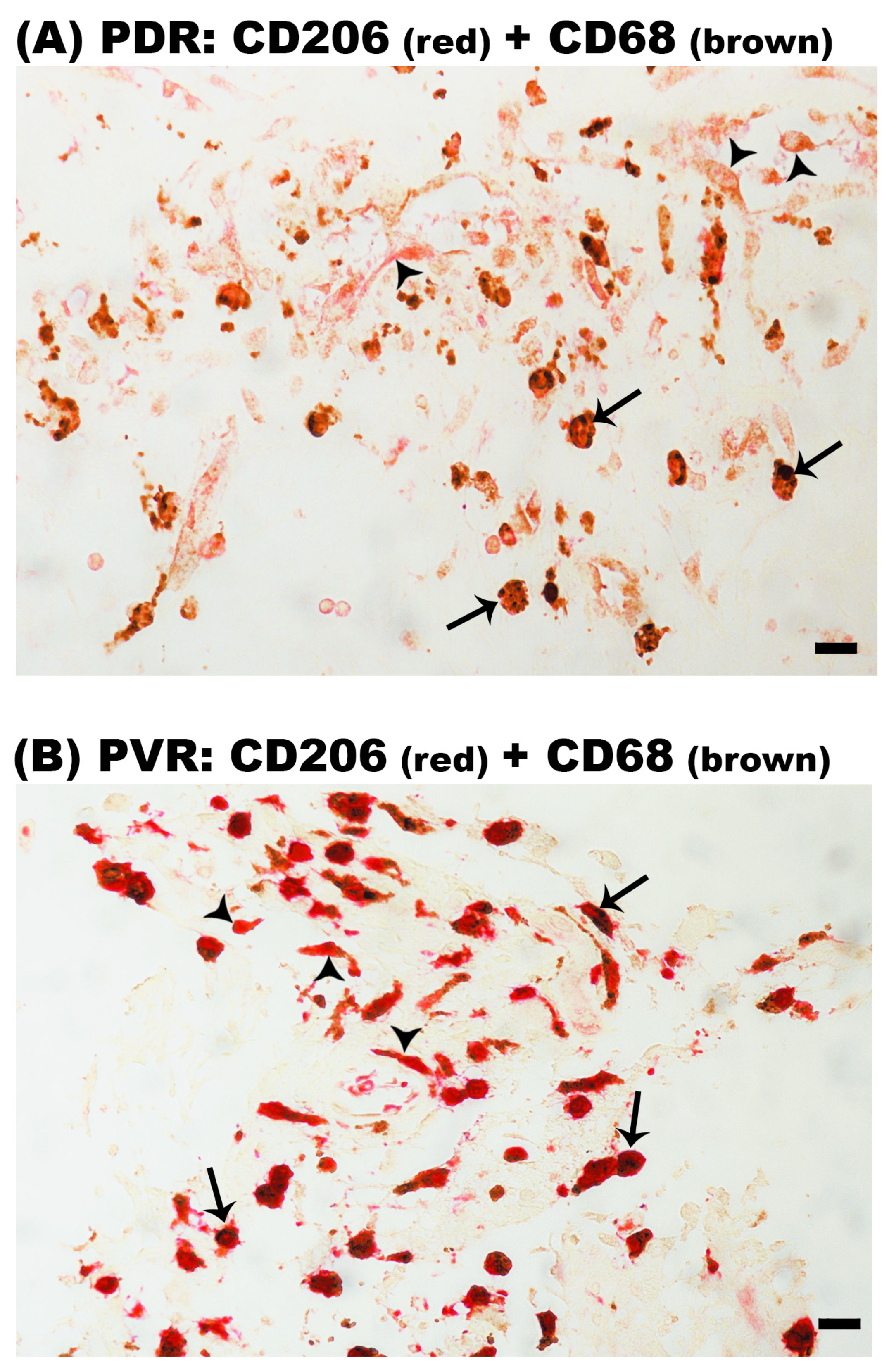
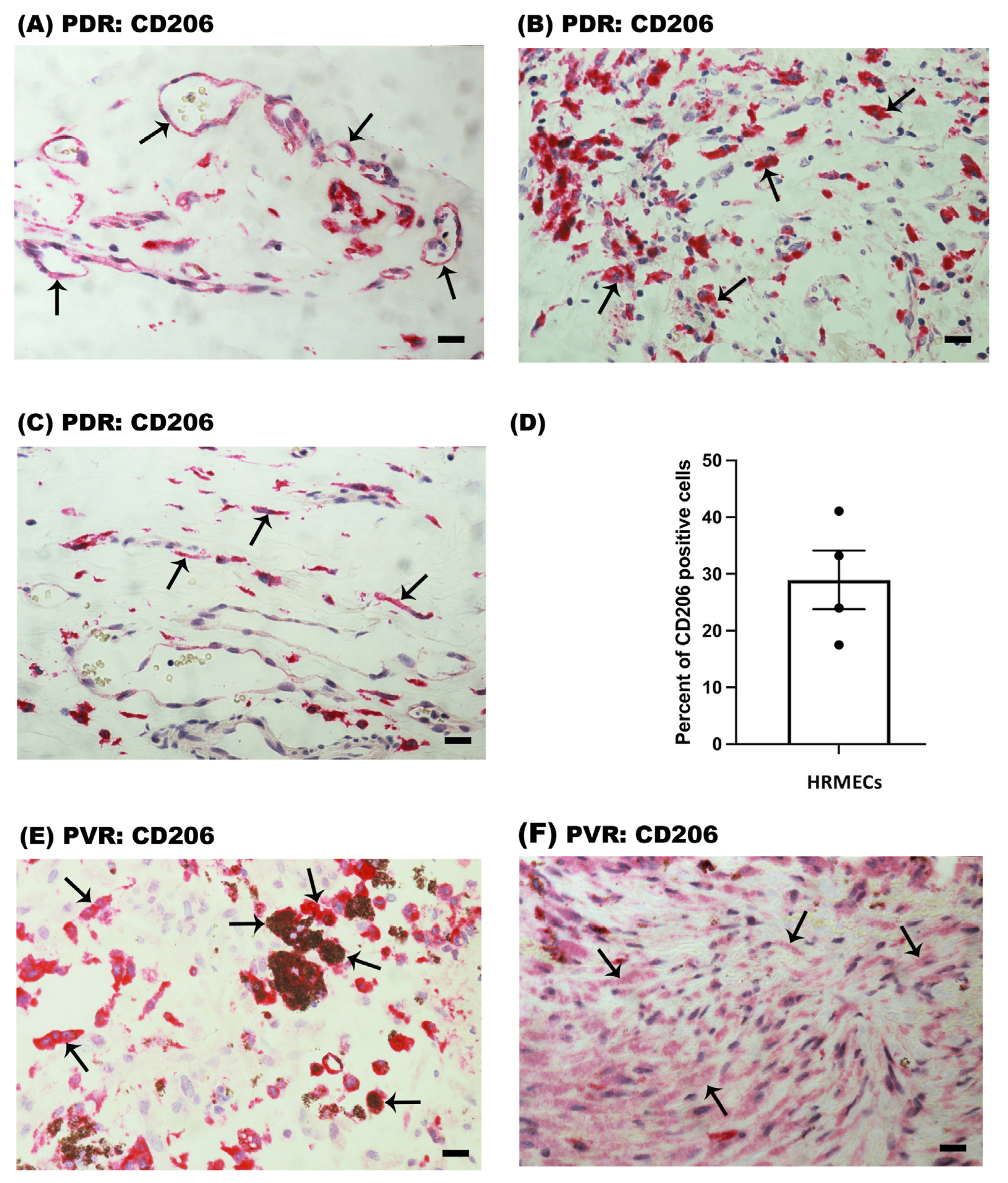
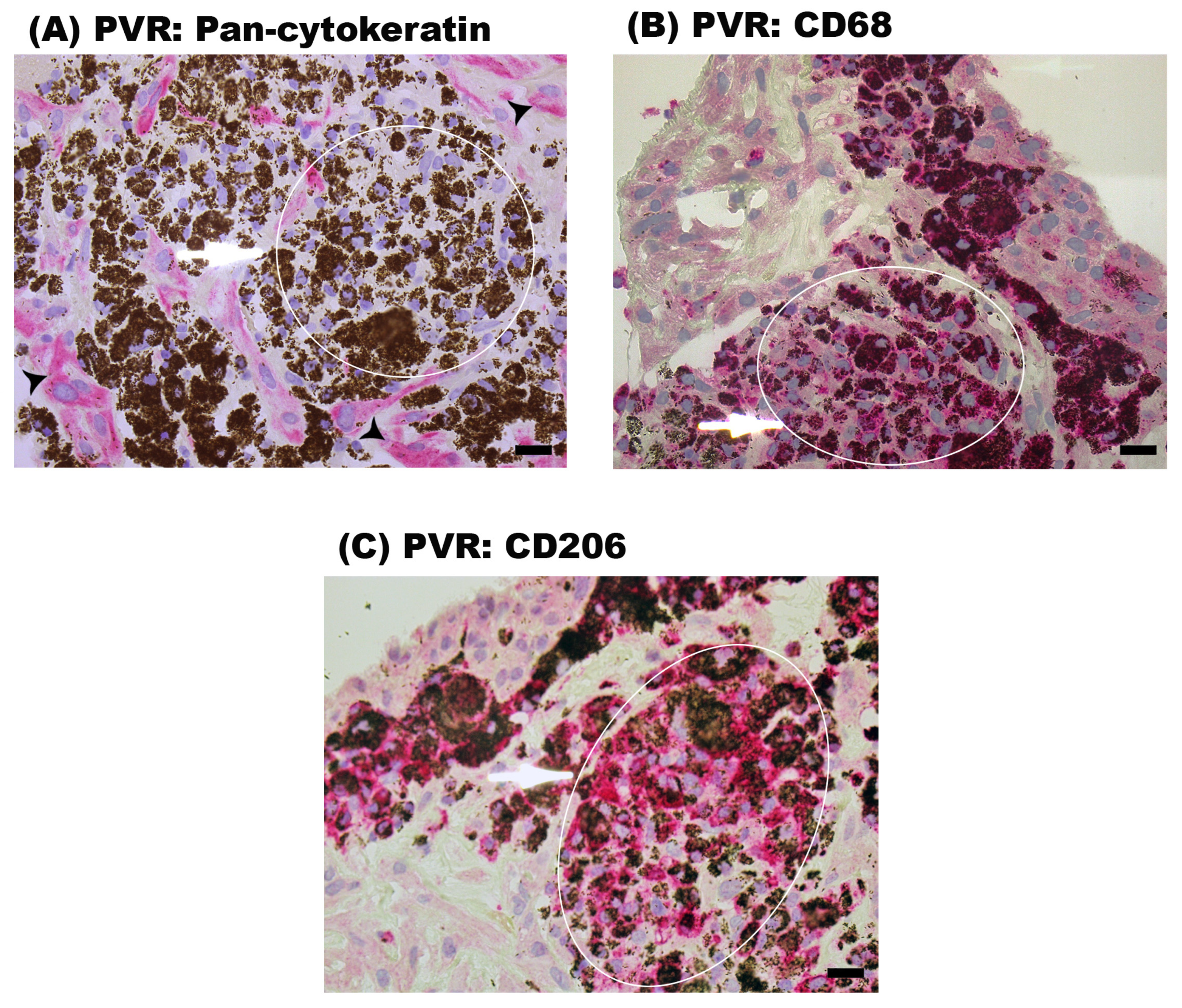
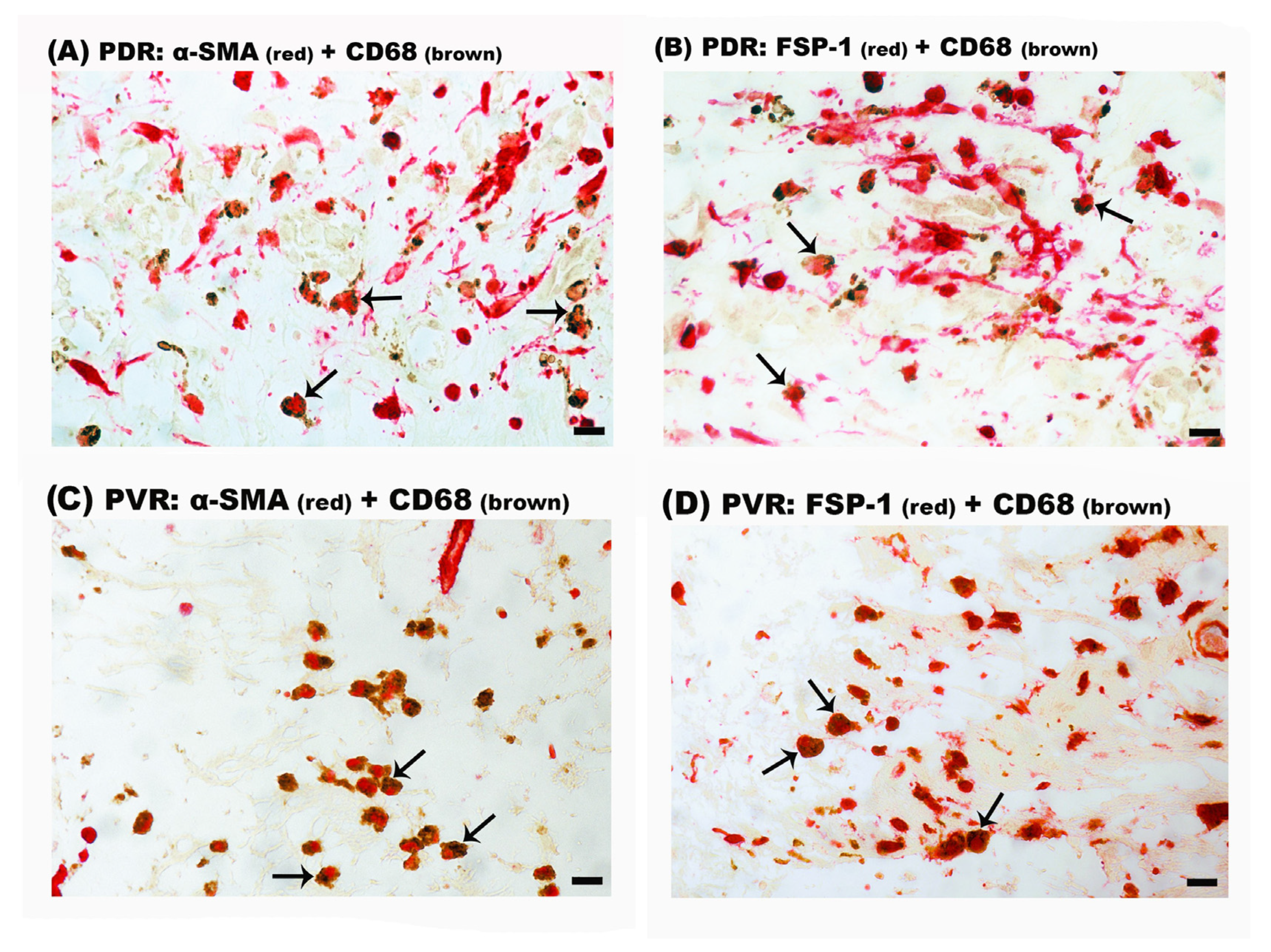
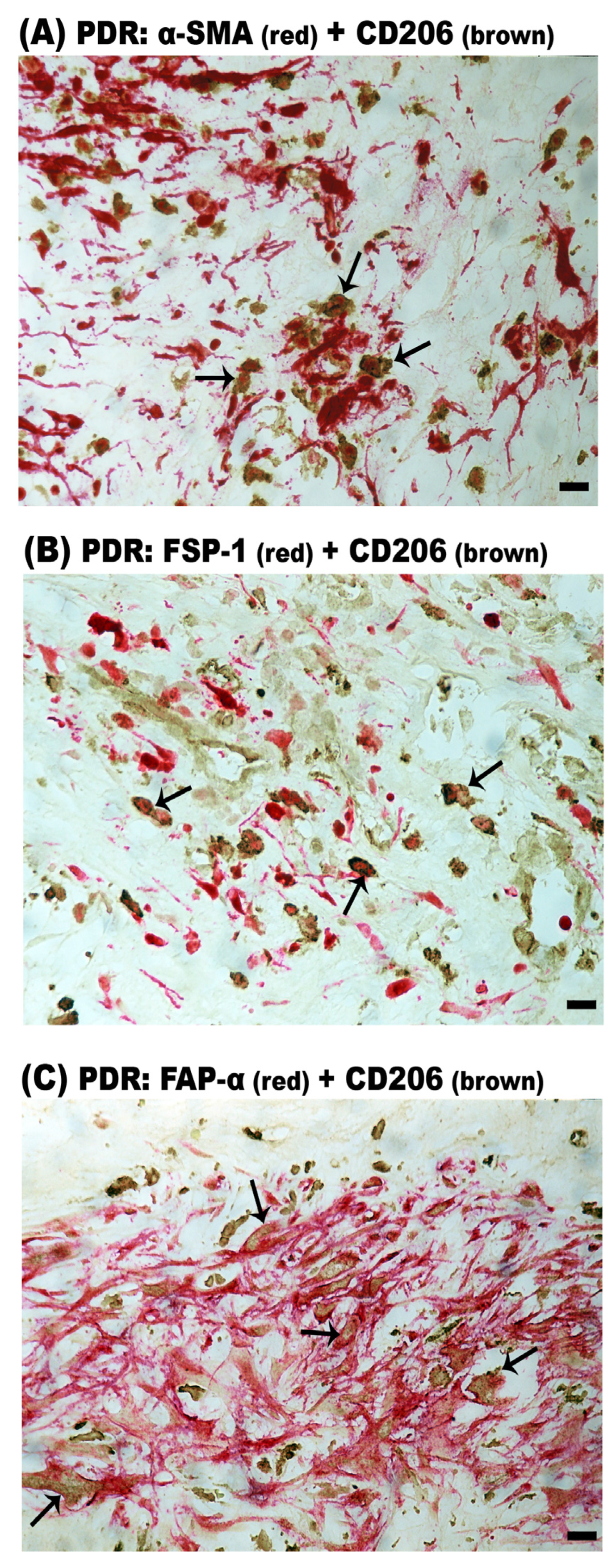
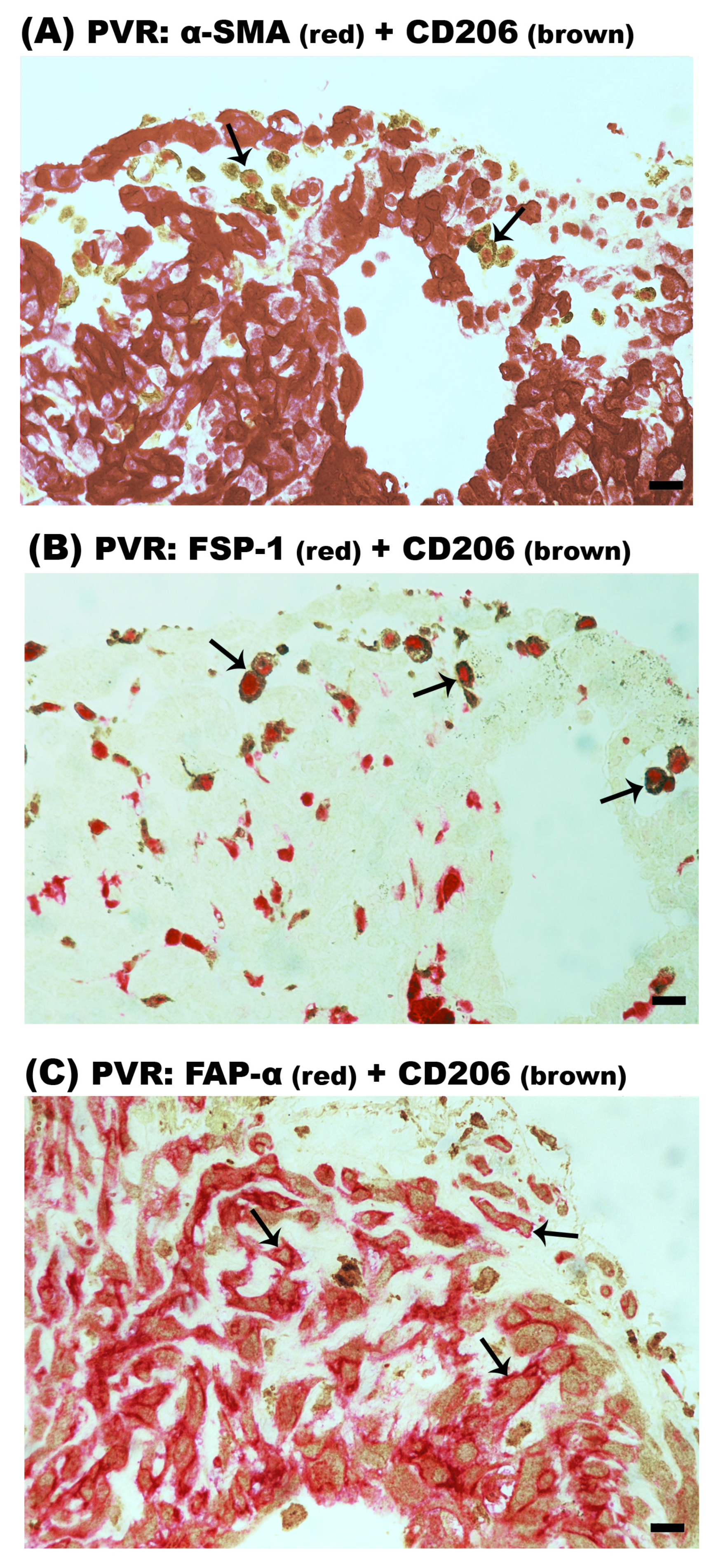
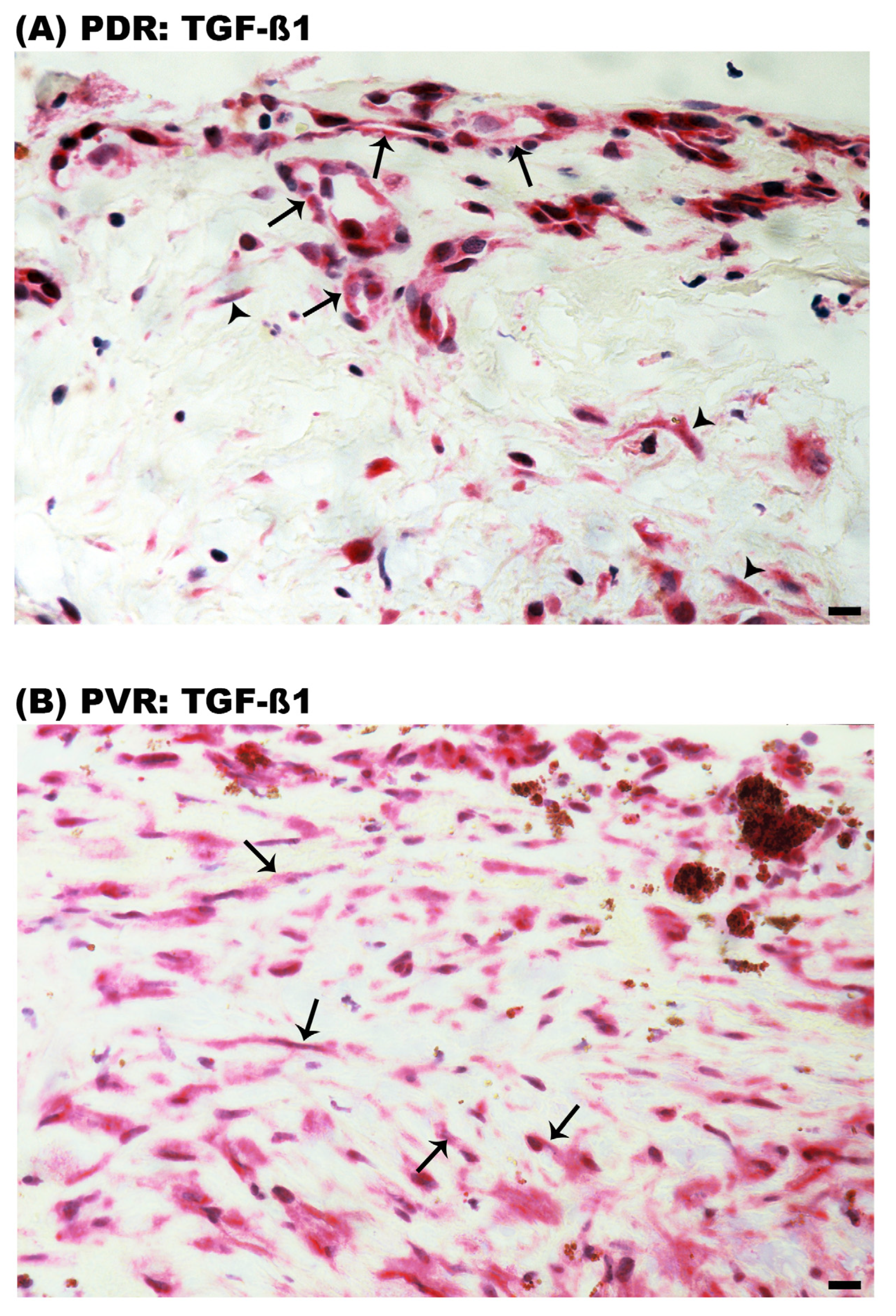
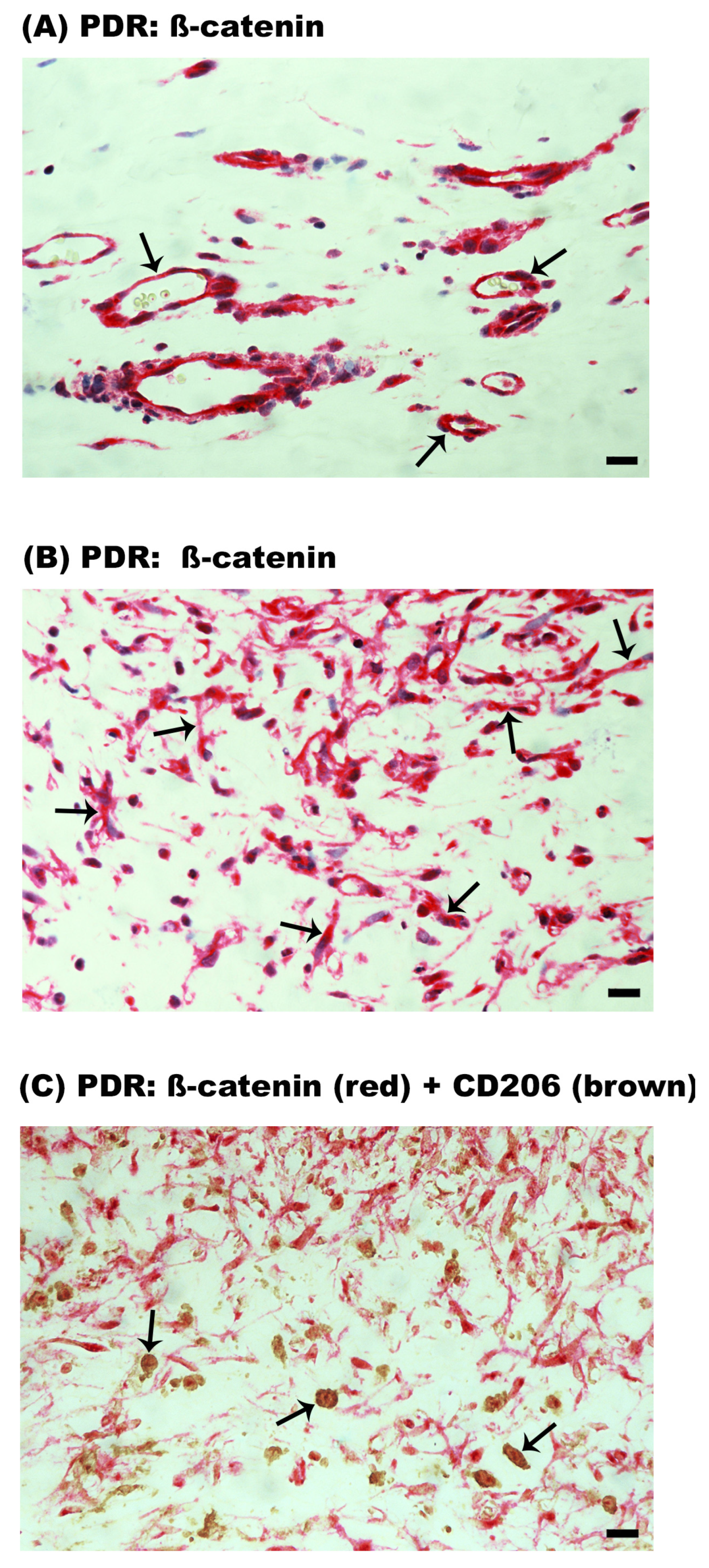
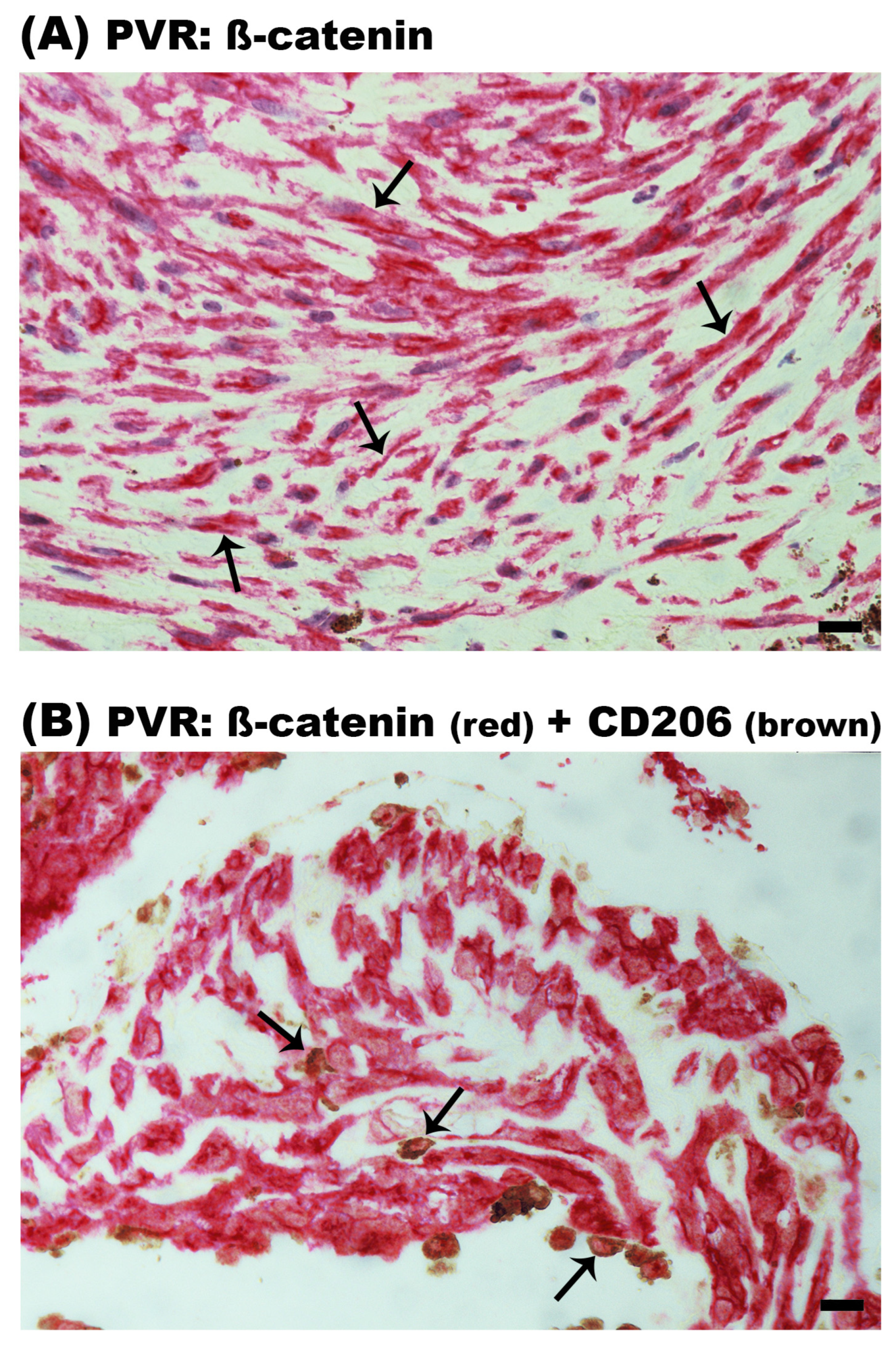
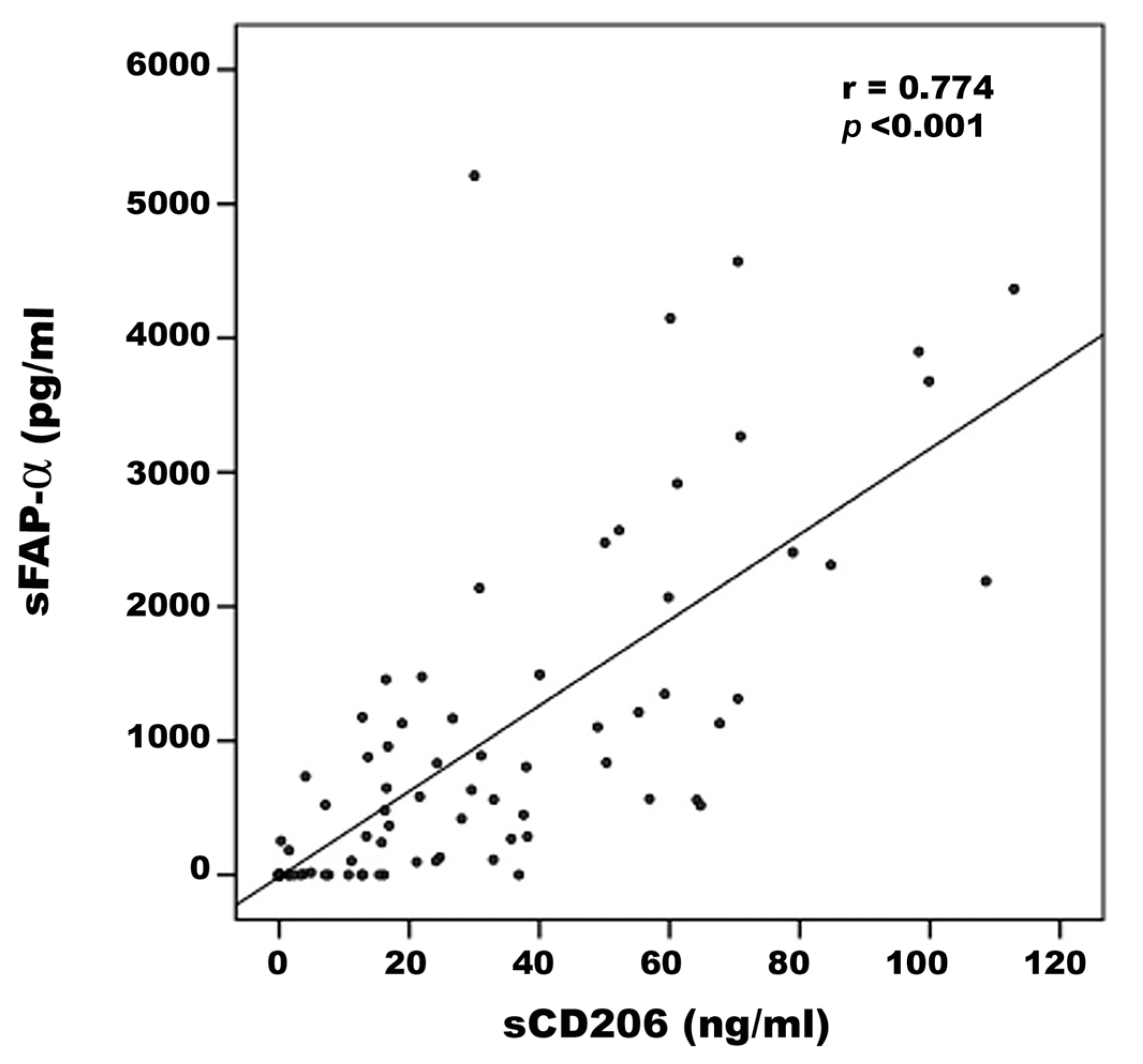
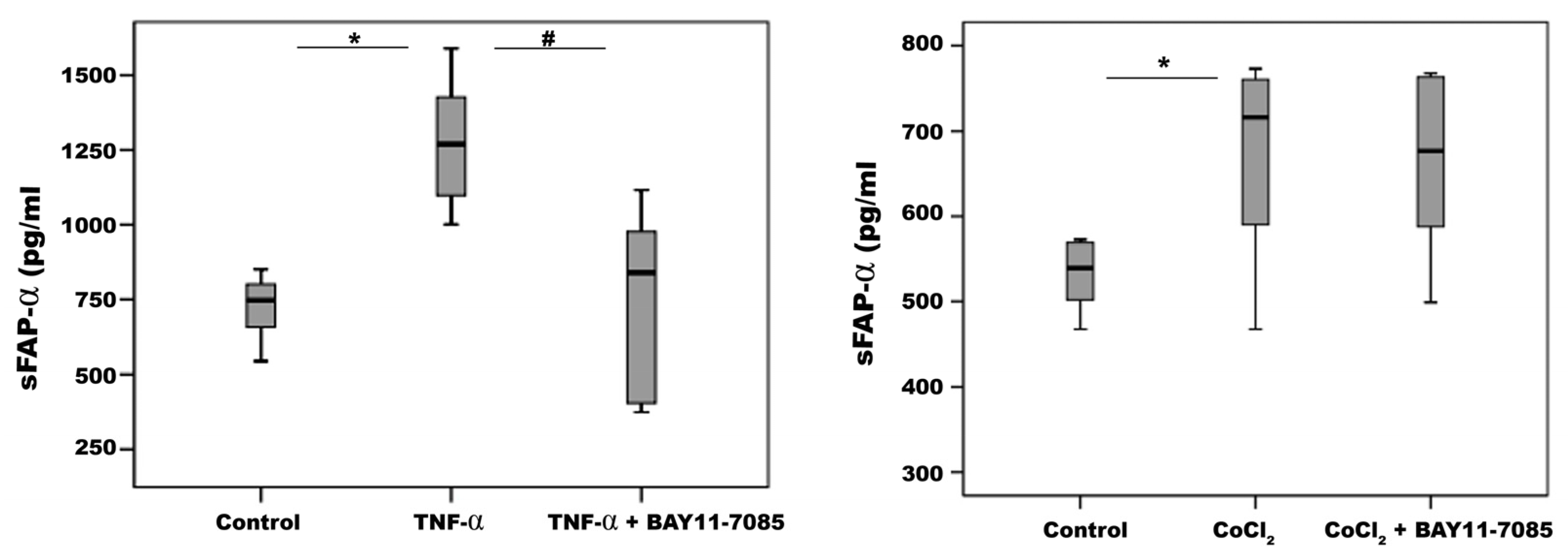
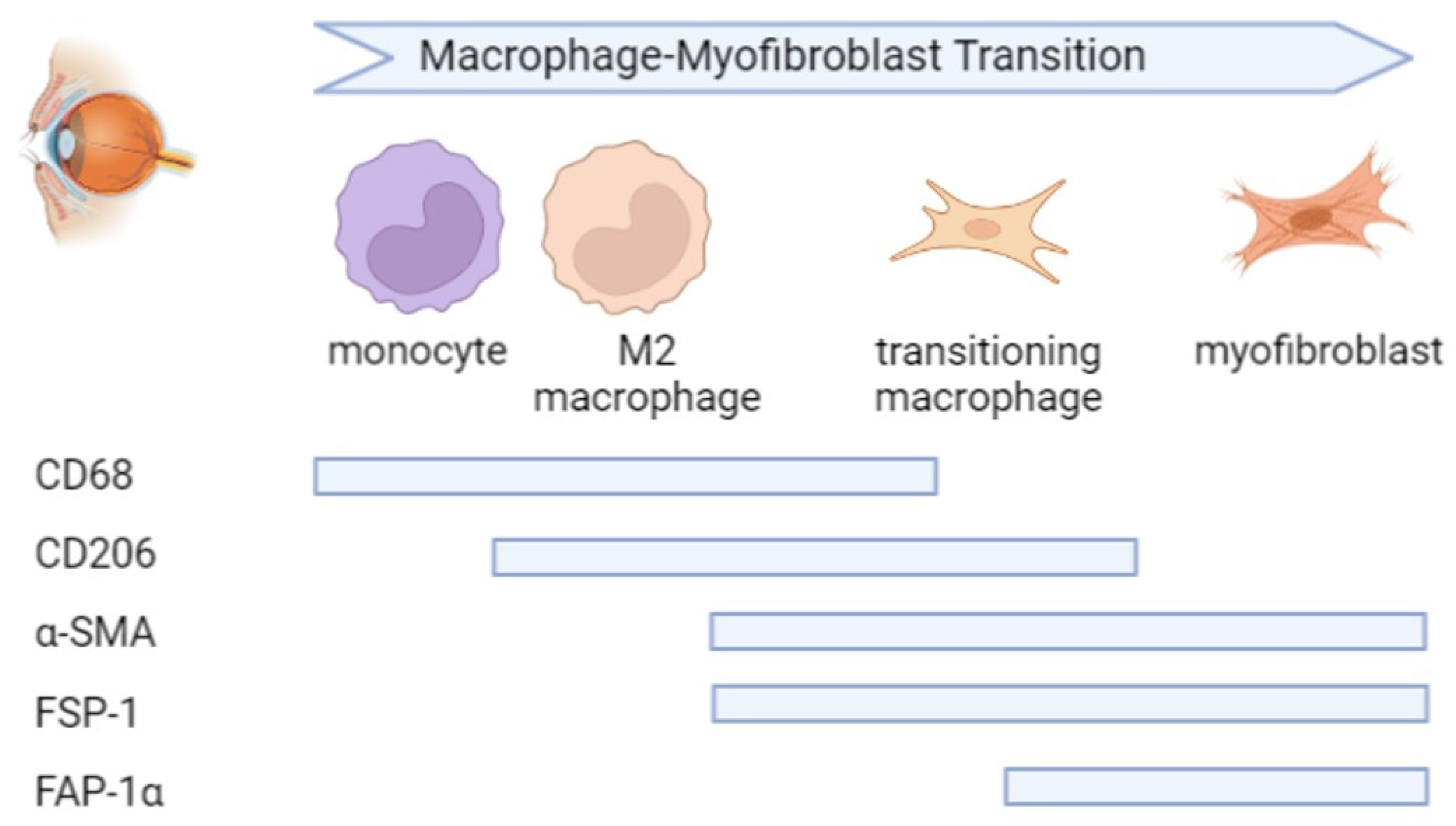
| Marker | PDR | PVR | ||
|---|---|---|---|---|
| Presence in Membranes * | Cell Type | Presence in Membranes | Cell Type | |
| Pigment | - | NA | + | M/M |
| CD31 | + | E | - | NA |
| CD68 | + | M/M, MMT | + | M/M, MMT |
| CD206 | + | M2, MMT, E | + | M2, MMT |
| CD86 | - | NA | - | NA |
| iNOS | - | NA | - | NA |
| α-SMA | + | MMT, MF | + | MMT, MF |
| FAP-α | + | MMT. MF | + | MMT, MF |
| FSP-1 | + | MMT. MF, E | + | MMT, MF |
| Pancytokeratin | - | NA | + | RPE |
| TGF-ß1 | + | E, MF | + | MF |
| ß-catenin | + | E, MF, M2 | + | MF, M2 |
| Disease Group | sCD206 (ng/mL) | sFAP-α (pg/mL) |
|---|---|---|
| RD (n = 30) Median (IQR) | 12.63 (1.57–21.35) | 57.00 (ND–308.25) |
| PDR (n = 38) Median (IQR) | 32.01 (16.63–59.9) | 1128.5 (549.5–2181.38) |
| PVR (n = 10) Median (IQR) | 60.84 (12.35–100.88) | 702.00 (ND–2777.00) |
| p-value (Kruskal–Wallis test) | <0.001 * | <0.001 * |
| Primary Antibody | Dilution | Source * |
|---|---|---|
| Anti-CD31 (Clone JC70A) (mc) | ready-to-use | Dako |
| Anti-α-smooth muscle actin (clone 1A4) (mc) | ready-to-use | Dako |
| Anti-CD68 (Clone KP1) (mc) | ready-to-use | Dako |
| Anti-CD206 (Cat No MAB25341) (mc) | 1/100 | R & D Systems |
| Anti-CD86 (Cat No 91882) (mc) | 1/100 | Cell SignalingTechnology |
| Anti-iNOS (Cat No ab115819) (mc) | 1/50 | Abcam |
| Anti-FAP- α (Cat No ab207178) (mc) | 1/250 | Abcam |
| Anti-FSP-1 (Cat No ab124805) (mc) | 1/500 | Abcam |
| Anti-TGF- ß1 (Cat No SAB4502954) | 1/50 | Sigma-Aldrich |
| Anti-ß-catenin (mc) | Ready-to-use | Agilent |
| Anti-pancytokeratin (Cat No NB120-11213) (mc) | 1/100 | Novus Biologicals |
Disclaimer/Publisher’s Note: The statements, opinions and data contained in all publications are solely those of the individual author(s) and contributor(s) and not of MDPI and/or the editor(s). MDPI and/or the editor(s) disclaim responsibility for any injury to people or property resulting from any ideas, methods, instructions or products referred to in the content. |
© 2023 by the authors. Licensee MDPI, Basel, Switzerland. This article is an open access article distributed under the terms and conditions of the Creative Commons Attribution (CC BY) license (https://creativecommons.org/licenses/by/4.0/).
Share and Cite
Abu El-Asrar, A.M.; De Hertogh, G.; Allegaert, E.; Nawaz, M.I.; Abouelasrar Salama, S.; Gikandi, P.W.; Opdenakker, G.; Struyf, S. Macrophage-Myofibroblast Transition Contributes to Myofibroblast Formation in Proliferative Vitreoretinal Disorders. Int. J. Mol. Sci. 2023, 24, 13510. https://doi.org/10.3390/ijms241713510
Abu El-Asrar AM, De Hertogh G, Allegaert E, Nawaz MI, Abouelasrar Salama S, Gikandi PW, Opdenakker G, Struyf S. Macrophage-Myofibroblast Transition Contributes to Myofibroblast Formation in Proliferative Vitreoretinal Disorders. International Journal of Molecular Sciences. 2023; 24(17):13510. https://doi.org/10.3390/ijms241713510
Chicago/Turabian StyleAbu El-Asrar, Ahmed M., Gert De Hertogh, Eef Allegaert, Mohd I. Nawaz, Sara Abouelasrar Salama, Priscilla W. Gikandi, Ghislain Opdenakker, and Sofie Struyf. 2023. "Macrophage-Myofibroblast Transition Contributes to Myofibroblast Formation in Proliferative Vitreoretinal Disorders" International Journal of Molecular Sciences 24, no. 17: 13510. https://doi.org/10.3390/ijms241713510
APA StyleAbu El-Asrar, A. M., De Hertogh, G., Allegaert, E., Nawaz, M. I., Abouelasrar Salama, S., Gikandi, P. W., Opdenakker, G., & Struyf, S. (2023). Macrophage-Myofibroblast Transition Contributes to Myofibroblast Formation in Proliferative Vitreoretinal Disorders. International Journal of Molecular Sciences, 24(17), 13510. https://doi.org/10.3390/ijms241713510







